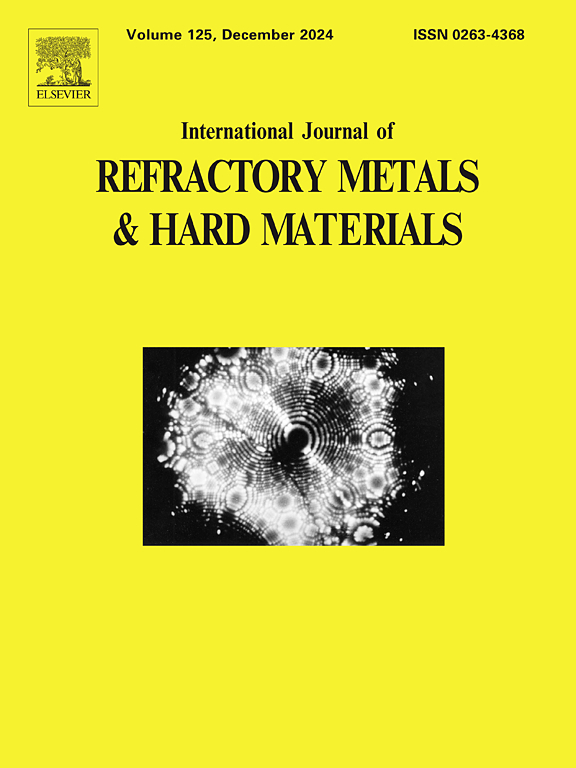Influence of feedpowder morphology on microstructure and mechanical properties of Tantalum produced by cold spray additive manufacturing
IF 4.2
2区 材料科学
Q2 MATERIALS SCIENCE, MULTIDISCIPLINARY
International Journal of Refractory Metals & Hard Materials
Pub Date : 2025-04-20
DOI:10.1016/j.ijrmhm.2025.107203
引用次数: 0
Abstract
In this study, two types of tantalum powders were deposited using cold spray additive manufacturing (CSAM). We focused on comparing the effects of hydride-dehydride polygonal tantalum powder (A-Ta) and plasma-atomized spherical tantalum powder (S![]() Ta) on the microstructure, mechanical properties, and tribological performance of the resulting deposits. Results revealed that under identical spraying conditions, A-Ta powder achieved a higher deposition efficiency (DE) of 86 %, compared to 61 % for S
Ta) on the microstructure, mechanical properties, and tribological performance of the resulting deposits. Results revealed that under identical spraying conditions, A-Ta powder achieved a higher deposition efficiency (DE) of 86 %, compared to 61 % for S![]() Ta powder. Both deposits demonstrated low porosity; however, the A-Ta deposit exhibited significantly superior mechanical properties, with a tensile strength of 350 MPa, approximately 2.1 times higher than the S
Ta powder. Both deposits demonstrated low porosity; however, the A-Ta deposit exhibited significantly superior mechanical properties, with a tensile strength of 350 MPa, approximately 2.1 times higher than the S![]() Ta deposit. Moreover, the A-Ta deposit showed enhanced wear resistance. At a heat flux density of 2.4 MW/m2, the A-Ta deposit demonstrated excellent ablation resistance, exhibiting a linear ablation rate of only −0.0012 μm/s after a 10-s exposure. These findings highlight the considerable potential of low-cost polygonal A-Ta powder for high-temperature ablation protection applications, establishing it as a promising candidate for CSAM of tantalum layers.
Ta deposit. Moreover, the A-Ta deposit showed enhanced wear resistance. At a heat flux density of 2.4 MW/m2, the A-Ta deposit demonstrated excellent ablation resistance, exhibiting a linear ablation rate of only −0.0012 μm/s after a 10-s exposure. These findings highlight the considerable potential of low-cost polygonal A-Ta powder for high-temperature ablation protection applications, establishing it as a promising candidate for CSAM of tantalum layers.
给粉形貌对冷喷涂增材制造钽显微组织和力学性能的影响
本研究采用冷喷涂增材制造技术(CSAM)沉积了两种类型的钽粉。我们重点比较了氢化-脱氢多边形钽粉(A-Ta)和等离子雾化球形钽粉(STa)对沉积层的微观结构、力学性能和摩擦学性能的影响。结果表明,在相同的喷涂条件下,a - ta粉末的沉积效率为86%,而STa粉末的沉积效率为61%。两个矿床均表现为低孔隙度;而a - ta合金的拉伸强度为350 MPa,是STa合金的2.1倍。此外,A-Ta沉积层的耐磨性增强。当热流密度为2.4 MW/m2时,a - ta沉积层表现出优异的抗烧蚀性能,在10-s的辐照下,线性烧蚀速率仅为−0.0012 μm/s。这些发现突出了低成本多边形a - ta粉末在高温烧蚀保护应用中的巨大潜力,使其成为钽层CSAM的有希望的候选材料。
本文章由计算机程序翻译,如有差异,请以英文原文为准。
求助全文
约1分钟内获得全文
求助全文
来源期刊
CiteScore
7.00
自引率
13.90%
发文量
236
审稿时长
35 days
期刊介绍:
The International Journal of Refractory Metals and Hard Materials (IJRMHM) publishes original research articles concerned with all aspects of refractory metals and hard materials. Refractory metals are defined as metals with melting points higher than 1800 °C. These are tungsten, molybdenum, chromium, tantalum, niobium, hafnium, and rhenium, as well as many compounds and alloys based thereupon. Hard materials that are included in the scope of this journal are defined as materials with hardness values higher than 1000 kg/mm2, primarily intended for applications as manufacturing tools or wear resistant components in mechanical systems. Thus they encompass carbides, nitrides and borides of metals, and related compounds. A special focus of this journal is put on the family of hardmetals, which is also known as cemented tungsten carbide, and cermets which are based on titanium carbide and carbonitrides with or without a metal binder. Ceramics and superhard materials including diamond and cubic boron nitride may also be accepted provided the subject material is presented as hard materials as defined above.

 求助内容:
求助内容: 应助结果提醒方式:
应助结果提醒方式:


